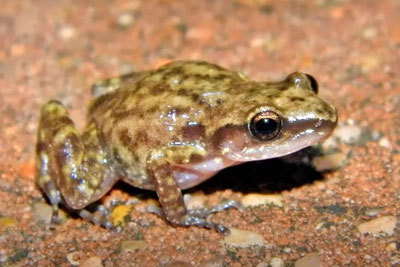Rio Grande chirping frogs
As I walked Zeus the dog up the driveway and out into the woods near our house I kept hearing sweet sounds that seemed new to my ears. It wasn’t the rasp of cicadas, and it didn’t sound like any bullfrogs I’d ever heard. I hadn’t seen any crickets. I was almost out of ideas.
Above is a recording I made on our driveway a little more than two weeks ago.
I came in the house and Googled “sounds of green tree frogs” and found no matches there. However, my computer sensed where I was (rural Collin County) and suggested I might want to listen to the sounds of Rio Grande chirping frogs. Spot-on!
We’ve seen what I thought were young frogs on our front porch this summer. Not many, and owing to the drought, I didn’t think much of it. We have frogs each year.
This frog thing isn’t really my part of science, but I was surrounded by these little voices that I didn’t recognize as I walked up the drive. There seemed to be dozens. Some were near the ground. Others sounded like they were fairly high up in the trees. And they sounded so cheerful. It’s been a fun search.

So, I reached out to the Wildlife Management people at Texas A&M. They put me in touch with Toby Hibbitts, curator of amphibians and reptiles of the biodiversity research and teaching collection at Texas A&M. Here was his reply to my plea:
You are correct on the ID. These frogs have exploded across Texas. They were restricted to their native range in the Lower Rio Grande Valley, and they were known from the Houston and Dallas areas in the late 80s. In the 90s they were found in places like College Station, San Antonio and Austin, and by the 2000s they seemed to be all over East Texas, especially around cities, but were also in natural habitats.
They call on humid nights usually when the temperatures are at least in the 60s. They aren’t specifically tree dwellers, but as noted, they do call from trees, bushes, vine tangles or just on the ground. Flowerbeds near houses are commonly used because they are usually watered and the houses themselves add a warm, stable environment. They can call any time of the year as long as the conditions are right.
Here are some other little factoids I picked up from other sources…
• These are small frogs, usually less than 1 inch in size.
• They lay their eggs in soil.
• The eggs hatch directly into small frogs, not tadpoles.
• As a result, they do not have to live near waterways like most frogs.
• They hitchhike readily in nursery potting soil, which is why we are finding them around major metropolitan areas of Texas and other surrounding states.
• Both males and females have calls, and they will be distinctive. If you have several in the landscape around you (as I did), you will hear distinct differences.
• Their chirping hit a peak in our landscape when the rains finally came through in late August. I’m hearing less out of them currently, even though I’m trying to keep my plants watered. I’m hoping their cheerful little calls will return when the rains return. Goodness, I’m just hoping the rains return!
Here is a YouTube video of one Rio Grande chirping frog tuning up.
https://youtu.be/K5rbUlsJxvI
And here is information from the U.S. Geological Survey. It shows that they’ve been around quite a while. Maybe I’m just one of the last to find out!
https://nas.er.usgs.gov/queries/factsheet.aspx?SpeciesID=64
Thanks also to Dr. Maureen Frank, Associate Professor and Extension Wildlife Specialist with Texas A&M AgriLife Extension Service in Uvalde for her help with my story. (She had to endure an email from me describing weeks I spent helping my dad with his TAMU herbicide research around Uvalde and how much I have enjoyed her lovely part of our state.)
